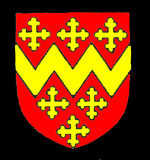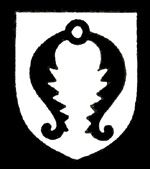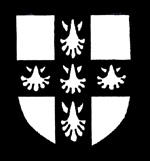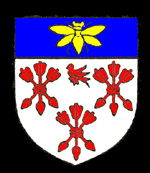Volume II of The Victoria County History for Bedfordshire, published in 1908, gives the history of manors in Sandy as far as they were known at the time. The Domesday Book of 1086 states that Eudo the Steward, also known as Eudo, son of Hubert, had a large holding of sixteen hides, one virgate in Sandy as well as numerous other holdings in Bedfordshire and other parts of the country.

The Engayne family coat of arms
Eudo died as late as 1120 and his estates were then taken by the Crown and granted to the Beauchamp family which held Sandy manor until 1347 when Roger de Beauchamp alienated it to John d'Engayne. It was then worth ten marks or £6/13/4 per annum. By the time Thomas d'Engayne died in 1367 the manor was worth a third more - £10 per annum.

The Barnacke family coat of arms
Thomas d'Engayne left three sisters as his heirs - Joyce, wife of John de Goldington, Elizabeth, wife of Laurence de Pabenham and Mary, wife of William Barnacke. Thomas' widow Katherine continued to hold the manor until her death in 1399 and it then, by agreement between the three co-heirs, descended to Mary Barnacke who was, by then, wife of Thomas la Zouche. Mary died the next year and was succeeded by her son John Barnacke, who died in 1409 leaving a son, John, who died in 1421 aged just twenty one. His brother Edmund died a few days after John and so their two sisters Joan and Mary were left as their heirs.

The Broughton family coat of arms
Mary married Robert Stoneham and became sole heir on the death of her sister. In 1437 Robert and Mary Stoneham secured the succession of their daughter Elizabeth by fine. She married John Broughton and Sandy manor remained in the Broughton family until the early 16th century when it passed to Katherine Broughton and, before 1560, to her daughter Agnes, who married William Paulet, Lord Saint John of Bletsoe.

The Stoneham family coat of arms
In 1572 Lord Saint John alienated Sandy Manor to Sir Robert Catlin, who was succeeded by his daughter Mary, wife of Sir John Spencer. Her son William was created Baron Spencer of Wormleighton in 1603 and held the manor at the time of his death in 1638. His son Henry was created Earl of Sunderland (at a cost of £3,000) and was killed fighting for King Charles I at the First Battle of Newbury in 1643 aged just 23. His son, Robert, sold Sandy manor to Sir Humphrey Monoux in 1670.
Sir Philip Monoux died in 1809 and his property was divided amongst his four sisters. His second sister Frances, wife of Samuel Ongley, received Sandy Manor. After her death the manor house and park (but not the manor itself) were sold to the Brandreth family, who sold it to the Foster family in 1872 and to Sir Robert Pearce Edgecumbe in 1877. He sold them to Walter Graves in 1905.

The coat of arms of Viscount Peel
Part of the Sandy Manor estate was bought by Sir William Peel VC (after whom a public house in the town is named), son of the prime minister Sir Robert Peel and, after his death in 1858, passed to his mother who died the following year and the property passed to her youngest son, Viscount Peel, who owned it into the 20th century. The Victoria County History noted "All manorial rights appear to be in abeyance".